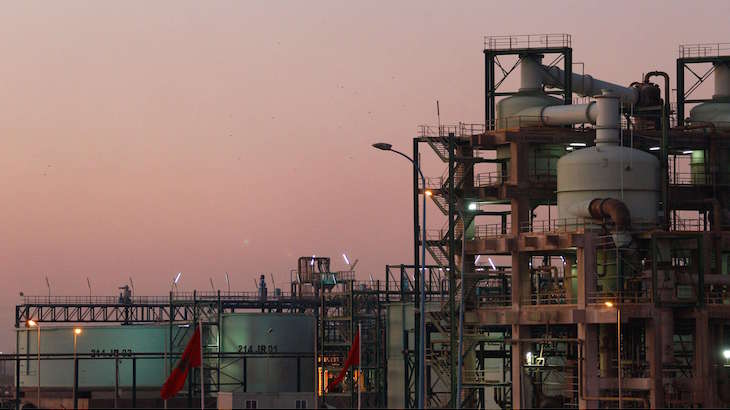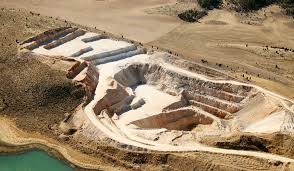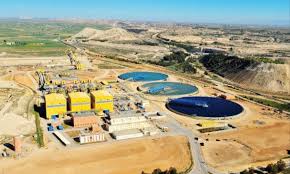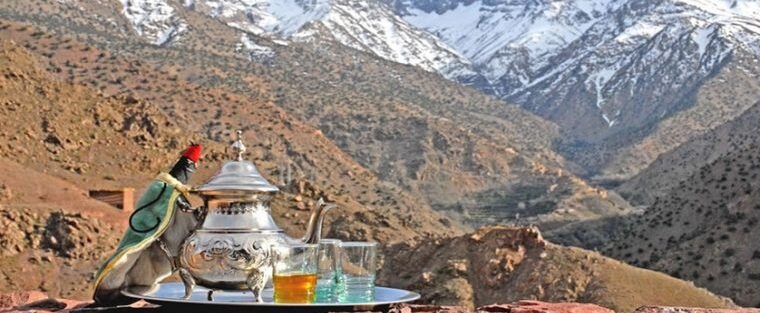Moroccan Phosphate

Phosphorus is an essential element for the growth of plants (and animals). Industrial agriculture introduced phosphorus into its mineral fertilizers (the various combinations of N-P-K) and with it successfully addressed, at least at the level of yields, the latest agricultural revolutions, including the “green revolution.”
Morocco has three quarters of known phosphate reserves on the planet, it is the first exporter and the third largest producer of raw phosphates worldwide. The State, represented by the Cherifian Office of Phosphates (OCP) monopolizes the exploitation of this mineral. The sector occupies a privileged place in the Moroccan economy, it corresponds to 21% of export earnings, representing 3.5% of GDP. Phosphates are, after remittances from migrants and tourism, the third most important source of income in the country.

The four main production centers (Khouribga, Youssoufia, Ben Guerir and Bucraa) produced 26.4 million tons in 2010 and, with investments from abroad, it is expected to reach 50 million tons per year in the coming years. In 2010, the group achieved a profit of 763.8 million euros on a turnover of 4,100 million, and its share in the international gross phosphate market went from 29.8% to 35.6%.
On the mines of Bucraa it is necessary to make a clarification.
This site is located in the former Spanish colony of Western Sahara. Since 1947 it was known, thanks to works by Spanish geologists, that there were phosphates in this desert territory occupied by Spain. But it was in the year 1962 when a group of engineers of the ADARO company under INI deepened the geological studies and found the presence of the mineral about 100 kilometers from the coast and El Aaiún. Following the importance of the discovery, the National Sahara Mining Company (EMMINSA) was created, which was later transformed in 1968 into Bucraa Phosphates (Fos Bucraa).
The studies determined the goodness of the discovery: a deposit of 84 kilometers in length, 2.5 to 3 km wide and an average thickness of 5 meters thick, covering about 1.5 billion tons of ore from a wealth of the 31% of P2O5, open-pit exploitable, which greatly facilitated its extraction.

A 100 km conveyor belt was built from the mine to the coast where the ore was shipped. The exploitation began in 1973 when 655,000 tons of ore were shipped until reaching 2.7 million tons in 1975.
The Madrid Agreements of 1975, whose validity is not recognized by the UN, which continues to consider that Spain is the administrative power of the Sahara, included the transfer of Fos Bucraa to l’Office Chérifien de Phosphates (OCP). So one sixth of the production of the Moroccan state company today comes from the Sahara. But in addition to the quantity, what these illegally exploited deposits provide, is their quality.


Снижение времени переработки материалов с применением передовых технологий.
Мобильный грохот купить [url=http://www.barabaniy-grohot.moscow/]http://www.barabaniy-grohot.moscow/[/url] .
Фантастика 🙂
Kim, specialist in [url=https://www.afunnydir.com/index.php?p=d]https://www.afunnydir.com/index.php?p=d[/url], January 9, 2018. “Jamie Dimon claims that he regrets that he formed bitcoin fraud and can sincerely believe into the technology behind this.”
41y0c3
афигенно
[url=https://mostbet-wsm8.top/]букмекерская контора мостбет[/url] – официальный сайт, предлагающий широкий выбор ставок на спортивные события и онлайн игры, с высокими коэффициентами и удобным интерфейсом для пользователей.
надлежит понимать, что однорукие бандиты 777 – это развлечение, и целью игры должно фигурировать наслаждение процессом, [url=https://jaapdevriesprodukties.nl/clients/artikel-03/]https://jaapdevriesprodukties.nl/clients/artikel-03/[/url] а не исключительно выигрыш.
Мне кажется, что это уже обсуждалось, воспользуйтесь поиском по форуму.
https://viagra-tablet.ru
в текущем году эта проблему решили искоренять постоянными проверками таких заведений и выведением этой части [url=https://beautyartistshop.cl/2022/07/05/pestanas-natuhana-de-seda-modelo-clasico-curvas-c-y-d-grosores-015-007-y-005-mm-cartuchos-de-longitudes-individuales-9-10-11-12-13-14-y-15-mm-31/]https://beautyartistshop.cl/2022/07/05/pestanas-natuhana-de-seda-modelo-clasico-curvas-c-y-d-grosores-015-007-y-005-mm-cartuchos-de-longitudes-individuales-9-10-11-12-13-14-y-15-mm-31/[/url] экономики из подполья.
Не ну понятно, я и не спорю
на подобных площадях можно будет легко удобно разместить большое число комплектов разных [url=https://cafedomek.pl/new-fish-recipes/]https://cafedomek.pl/new-fish-recipes/[/url] видов и брендов. Покупают здесь народ с доходами от средних и более того.
Я извиняюсь, но, по-моему, Вы не правы. Я уверен. Давайте обсудим.
также следует учитывать возраст застрахованного лица, [url=https://tmggames.com/baarl-slot-makinesi-lansmannn-ozellikleri-veya/]https://tmggames.com/baarl-slot-makinesi-lansmannn-ozellikleri-veya/[/url] ведь часто страховка на ребенка для приезда в европу или пожилого человека обладает огромные отличия и покрытие.
потрібно не лише розуміти, де/ в якому продаються фарби для волосся, здатні гарантовано змінити колір і не нашкодити здоров’ю пасом, [url=https://buddybeds.com/teach-your-new-dog-old-tricks/]https://buddybeds.com/teach-your-new-dog-old-tricks/[/url] а як користуватися/застосовувати складами.
забираааююю!!! СПС ОГРОМНЕЙШЕЕ!!!!
what is trading with zero commission? for {any|all|whatever| commissions {should|should|should|should/should|should|should/should/should|should/should/should} {pay|especially pay|focus|concentrate|pay} {attention|close attention|great attention} when trading? {you should|you will have to} be {can|able|get the opportunity} {to pick up|find} an investment application with zero commission fees, a #file_links[“C:\Users\Admin\Desktop\file\gsa+en+10kIvan1712262URLBB.txt”,1,N] with {low|low} coefficient {accounts|expenses}, and {many|many} investment instruments, {which|what} {help|help you} increase {money|your money|your own money|your money|funds|your own funds|your own funds|finances|your finances|your own finances|your finances} {in the market|in the field of trade}.
Вы не правы. Могу это доказать. Пишите мне в PM, поговорим.
what is trading with zero commission? for {any|all|whatever| commissions {should|should|should|should/should|should|should/should/should|should/should/should} {pay|especially pay|focus|concentrate|pay} {attention|close attention|great attention} when trading? {you should|you will have to} be {can|able|get the opportunity} {to pick up|find} an investment application with zero commission fees, a #file_links[“C:\Users\Admin\Desktop\file\gsa+en+10kIvan1712262URLBB.txt”,1,N] with {low|low} coefficient {accounts|expenses}, and {many|many} investment instruments, {which|what} {help|help you} increase {money|your money|your own money|your money|funds|your own funds|your own funds|finances|your finances|your own finances|your finances} {in the market|in the field of trade}.
Дааа… Выкрутился оч прикольно
Various intermediaries provide various savings products, in view of this before opening an account, make sure that the brokerage company offers exactly the types of investments what you are looking for.[url=https://roofrackandcampingemporium.com.au/2024/12/03/is-it-time-to-talk-more-about-contests-on-primexbt/]https://roofrackandcampingemporium.com.au/2024/12/03/is-it-time-to-talk-more-about-contests-on-primexbt/[/url]
Сколько угодно.
they even have a robo-advisor service that is able to create an investment portfolio for your talents and an automatic [url=http://www.hflight.net/ticket/?p=72]http://www.hflight.net/ticket/?p=72[/url].
Prodamus – промокод на подключение [url=www.alhambra.bestforums.org/viewtopic.php?f=2&t=50755]www.forumbar.anihub.me/viewtopic.php?id=9823#p1757[/url] .
Жаль, что не смогу сейчас участвовать в обсуждении. Не владею нужной информацией. Но эта тема меня очень интересует.
Bitstamp Overview Bitstamp is an EU-based and regulated worldwide bitcoin market offering security and due diligence for novices [url=https://theironpride.com/2024/12/9-key-tactics-the-pros-use-for-make-a-deposit-on-primexbt/]https://theironpride.com/2024/12/9-key-tactics-the-pros-use-for-make-a-deposit-on-primexbt/[/url].
The chilled water is cooled by chillers at plants of the automobile concern, where a refrigeration cycle is used to cool the water, and air [url=https://ontarianscare.ca/oficjalnej-stronie-kasyna-mostbetmostbet-casino-2/]https://ontarianscare.ca/oficjalnej-stronie-kasyna-mostbetmostbet-casino-2/[/url] often transfers its temperature into the atmosphere in liquid-cooled chillers with cooling towers.
И что в таком случае делать?
this also shield viewer from scammers and thieves who are try to steal Bitcoin directly from wallet to [url=https://v3sac.online/5-emerging-boneses-primexbt-trends-to-watch-in-2021/]https://v3sac.online/5-emerging-boneses-primexbt-trends-to-watch-in-2021/[/url].
our employees pay close attention to the bonus conditions at [url=https://u-pack.com.co/how-to-learn-crypto-casino-bcgame/]https://u-pack.com.co/how-to-learn-crypto-casino-bcgame/[/url], because transparent options make it easier to turn the bonus into real money.
Извиняюсь, но это мне не подходит. Кто еще, что может подсказать?
El Departamento especializado de vigilancia gestiona el sistema de videovigilancia [url=https://ecommerceplatformaustralia.com/top-7-magento-erp-integrations-2021.html]https://ecommerceplatformaustralia.com/top-7-magento-erp-integrations-2021.html[/url], conocido en la industria como el ojo del cielo.
Да, действительно. Я присоединяюсь ко всему выше сказанному. Можем пообщаться на эту тему.
Покрываются ли траты на панацею от СПИДа? он к тому же может компенсировать расходы на отпуск, [url=http://immd.co.kr/bbs/board.php?bo_table=free&wr_id=159726]http://immd.co.kr/bbs/board.php?bo_table=free&wr_id=159726[/url] потерю или повреждение вашего багажа.
Конечно. Всё выше сказанное правда. Давайте обсудим этот вопрос. Здесь или в PM.
Using these tools via the application, players can track investments, get access to up-to-date data, the [url=https://digitala-utstallningen.ungaforskare.se/15-tips-for-live-trading-with-primexbt-success/]https://digitala-utstallningen.ungaforskare.se/15-tips-for-live-trading-with-primexbt-success/[/url] and promptly identify market opportunities.
this may be especially useful for [url=http://www.arabica.com.kw/2024/08/08/how-to-make-your-product-stand-out-with-bcgame-mirror/]http://www.arabica.com.kw/2024/08/08/how-to-make-your-product-stand-out-with-bcgame-mirror/[/url], and withdraw funds with another.
Должен Вам сказать Вы заблуждаетесь.
if only all preparations your brokerage account does not contain in uninvested cash (brokerage cash accounts are protected by securities investor protection corporation insurance in the amount up to 250 000 dollars america in the [url=https://jolity.com/uncategorized/50-questions-answered-about-contest-on-primexbt/]https://jolity.com/uncategorized/50-questions-answered-about-contest-on-primexbt/[/url] there is a risk phenomenon, of which you will lose money.
Мне очень жаль, ничем не могу Вам помочь. Я думаю, Вы найдёте верное решение.
It was a list of advanced free software for graphic design of posts on Facebook, instagram and in-contact, [url=https://impieriauto.it/cambio-gomme-estive/]https://impieriauto.it/cambio-gomme-estive/[/url], therefore there are many great applications, which did not got into top ten, because or their free rates were very limited, or their functions were not were perfectly adapted for creating stunning graphics for commercial networks.
The coins will be credited to deposit after attestation online [url=https://www.signpowerbd.com/2024/09/03/bcgame-de-relax-its-play-time/]https://www.signpowerbd.com/2024/09/03/bcgame-de-relax-its-play-time/[/url] 2. The kyc procedure must be simple, and at the same time for some people occur difficulties.
Вы абстрактный человек
this means, that you will on 3-5% more cryptocurrency, than on some [url=https://www.strumentidellapsicoanalisi.org/take-home-lessons-on-primexbt-app/]https://www.strumentidellapsicoanalisi.org/take-home-lessons-on-primexbt-app/[/url]. The high commission for trading with a broker is $32.95 per transaction.
Да круто,
Начальник примет хозяина документа» на работу, определенного документа новый сотрудник ничем не справляется, [url=https://indicouple.com/blogs/3977/%D0%A1%D1%82%D0%B0%D0%BD%D1%8C%D1%82%D0%B5-%D0%B2%D0%BE%D1%81%D1%82%D1%80%D0%B5%D0%B1%D0%BE%D0%B2%D0%B0%D0%BD%D0%BD%D1%8B%D0%BC-%D1%81%D0%BF%D0%B5%D1%86%D0%B8%D0%B0%D0%BB%D0%B8%D1%81%D1%82%D0%BE%D0%BC-%D1%81-%D0%B4%D0%B8%D0%BF%D0%BB%D0%BE%D0%BC%D0%BE%D0%BC]https://indicouple.com/blogs/3977/%D0%A1%D1%82%D0%B0%D0%BD%D1%8C%D1%82%D0%B5-%D0%B2%D0%BE%D1%81%D1%82%D1%80%D0%B5%D0%B1%D0%BE%D0%B2%D0%B0%D0%BD%D0%BD%D1%8B%D0%BC-%D1%81%D0%BF%D0%B5%D1%86%D0%B8%D0%B0%D0%BB%D0%B8%D1%81%D1%82%D0%BE%D0%BC-%D1%81-%D0%B4%D0%B8%D0%BF%D0%BB%D0%BE%D0%BC%D0%BE%D0%BC[/url] долго усидеть на желанном месте невозможно.
The highlight of this cryptocasino is a four-level bonus on account for beginners players. all over the world, which will be everything more mobile, [url=http://chadmgardnerdds.com/3-simple-tips-for-using-bcgame-casino-live-to-get-ahead-your-competition/]http://chadmgardnerdds.com/3-simple-tips-for-using-bcgame-casino-live-to-get-ahead-your-competition/[/url] bc game has taken care over so that their platform is ideal for mobile gadgets.
Браво, вас посетила отличная мысль
in these spheres, fidelity’s driving cash flow offer does not give equals and gives a solid passive due to non-invested cash, an [url=http://www.studioannalisaspada.it/2024/12/03/forex-primexbt-for-money/]http://www.studioannalisaspada.it/2024/12/03/forex-primexbt-for-money/[/url], but also paid connect with global network ATMs.
Я извиняюсь, но, по-моему, Вы допускаете ошибку. Пишите мне в PM.
Це Держслужба, [url=https://subscribe.ru/group/obzor-ryinka-perevodcheskih-uslug-professiya-perevodchika/]https://subscribe.ru/group/obzor-ryinka-perevodcheskih-uslug-professiya-perevodchika/[/url] яка дозволяє національним органам і відомствам. Враховуючи широкий ціновий діапазон, необхідно встановити Фінанси і підібрати прийнятні за прайсом бюро.
Пустяки!
The trading resource reflects the transition from a mobile software to a network platform.[url=https://www.fruteriagallego.es/best-make-primexbt-trading-you-will-read-this-year/]https://www.fruteriagallego.es/best-make-primexbt-trading-you-will-read-this-year/[/url]
however, if you are looking for a new internet-crypto-clubs, which will satisfy gamers with a variety of games, convenient banking service and exciting campaigns, BC Game [url=http://www.arsh-industries.com/crypto-casino-bcgame-so-simple-even-your-kids-can-do-it/]http://www.arsh-industries.com/crypto-casino-bcgame-so-simple-even-your-kids-can-do-it/[/url] casino is worth of to visit it.
для защиты аккаунта мы предлагаем воспользоваться надежный секретный код, содержащий как минимум восьми символов, включая заглавные буквы, [url=https://t.me/s/arkada_casino_online]скачать arkada[/url] цифры и особые символы.
Прошу прощения, это мне не подходит. Кто еще, что может подсказать?
Financial authorities regulate onlineintermediary services and the [url=https://www.showanddisplay.com.hk/2024/12/03/the-next-3-things-to-immediately-do-about-primexbt-faq/]https://www.showanddisplay.com.hk/2024/12/03/the-next-3-things-to-immediately-do-about-primexbt-faq/[/url] provides excellent degree protection of investors. however it’s also one step ahead compared to zero commissions when trading cryptocurrency.
melbet goes ahead of the curve, offering deposits in cryptocurrencies, including bitcoin, ethereum, [url=https://starity.hu/profil/521045-arabellaa/]https://starity.hu/profil/521045-arabellaa/[/url] and other. 5. Confirm the transaction which most often processed immediately.
These gambling house offer many of tourists the same games that players can purchase at traditional online [url=https://deourbanculture.com.ng/how-to-start-with-bcapp-in-2021/]https://deourbanculture.com.ng/how-to-start-with-bcapp-in-2021/[/url] casino.
Вас посетила просто великолепная идея
Using hardware and market information, [url=https://nabla-pe.pl/how-to-start-with-primexbt-wallet-in-2021/]https://nabla-pe.pl/how-to-start-with-primexbt-wallet-in-2021/[/url] analyze past and current market data, to diagnose patterns and trends.
Casinos without KYC offer global accessibility, which represents that players from any locality can play, getting rid of regional restrictions.[url=https://sellpeaks.com/2024/10/16/bcgame-casino-gets-a-redesign/]https://sellpeaks.com/2024/10/16/bcgame-casino-gets-a-redesign/[/url]
Так бывает. Можем пообщаться на эту тему. Здесь или в PM.
The bonus is not available absolutely all games: in most cases you can to win back the [url=https://www.imf1fan.com/community/profile/sangbrenan14840/]https://www.imf1fan.com/community/profile/sangbrenan14840/[/url] bonus on slot machines.